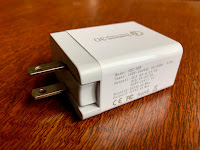Travel and Leisure
Yep. The writers' strike is still going on. So what to write about today? I just gave my brother two of my NA to EU plug adapters for his first trip to Europe, and this is a hot topic of confusion for many first-time travellers across the Atlantic, so here goes. Disclaimer: While I am/was an electrical engineer, please do your own due diligence with respect to using electrical devices in Europe.The first thing that you should do, is take a mental inventory of anything electrical that you will want to bring abroad. Our list is something like this:
- 2 x iPads
- 2 x iPhones
- 1 x power bank
- 1 x bluetooth speaker
- 1 x pair bluetooth earbuds (for RS Audio Tours)
- 1 x hair straightening iron
Once you've figured out what you will need electricity for, turn each device over (or the power adapter for each) and try to read the tiny writing on the side. I use the device pictured above for the first five items on my list (it has three USB charging ports), and it reads "Input: 100V-240VAC 50/60Hz". So for this USB charger (and likely any device like it), you are good to handle the EU power system of 220V and 50 Hz, and you simply need to "adapt" the NA flat prongs to the local outlets. While most EU countries use a round, recessed socket, the Swiss use a hexagonal one. That's why I recommend getting ones that fit the Swiss one, as they also fit the round ones too. These ones on Amazon 2 for $6 should do the trick.
With North American hair appliances, you do actually need to "convert" the power. This is where it gets tricky. I'll start off by saying that you can leave your fancy Dyson hair dryer at home. Europeans have hair dryers too, and we've never run into a situation where there wasn't one in the hotel room or Airbnb. But for curling irons and hair straighteners, I had purchased a converter that I thought would be appropriate for these high current devices (pictured). While it did supply power to her flat iron, it didn't quite heat up properly, and only got slightly better than warm. Based on this experience, I don't recommend trying to buy one of these power converters.
However, if you are going to go this route, beware that many of the $20 ones listed on Amazon don't actually perform any voltage conversion, despite showing a picture of a North American-style outlet, and the word "converter" used in the description. If you read the fine print carefully, you'll see notes like, "NOT a Voltage Converter: This travel converter for Europe only works on 100V to 250V voltage devices". Plug your beloved hair straightener into one of these, and you're going to quickly create a fire hazard. There are more expensive ($40+) ones I have seen on Amazon that indicate support for 2000W, but when you read the description, it states the rating is not for the 110V "converted" socket. Confused? You should be.
My recommendation for anyone that wants/needs to curl or straighten their hair in Europe, is to buy a dual-voltage model. She ended up buying this one on Amazon for less than $30, and indicated that it's as good as the NA power-only one she uses at home.
The other device that I can think of that people might need while travelling is a CPAP machine. I can't guarantee it, but it would seem that most have an external power supply that converts a wide range of AC voltages to DC. i.e. you should only need the aforementioned adapters to power your machine.
And while there are those folks who are on river cruises that might have a North American outlet in their room on the ship, that won't help you in the hotels before and after your cruise itinerary. One final parting tip, is that if you are really in a bind, and need to recharge your iPhone, there's likely a USB port on the side or back of the TV in your room. It probably won't supply enough current to charge an iPad, but should work for your smartphones.
Happy travels!






